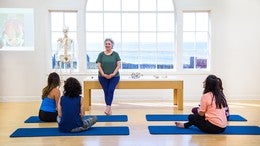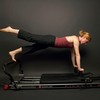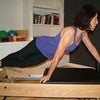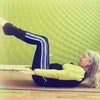Description
About This Video
Transcript
Read Full Transcript
Hi, I'm Lesley Powell. I'm from Movements Afoot. And today we're gonna do a workout using embodied anatomy. And our theme today is gonna be about the psoas. And one thing I want you to think about when we work with this idea is how it's gonna create space in your body.
We're not always gonna feel like it's a bicep curl, but it's gonna make you think differently in your practice. To just review, if you want, put your hands. Imagine, if you put your hands up here and you could touch your spine, that's the top of your psoas, and it detaches to the front of the, kind of to the side of the spine. And if you were to draw down, it attaches to the inside of the thigh bone called the lesser trochanter. Then you have your iliacus, and it attaches back on the iliac crest and it goes down and it shapes into it.
And again, it goes down to the lesser trochanter. Then your psoas minor, it attaches on the pubic bone. And then I want you to visualize that it slides up and follows that psoas line. Okay. So we're gonna constantly look at and observe that space.
And the thing also is when we get into more advanced Pilates exercises, one reason all abdominal exercises ask us to put a load on the psoas to challenge the abdominals. And when you start thinking about the space and that length, it gets your abdominals work differently. So ladies, I would like you to lie on the reformer with the over ball underneath your pelvis. And right now you could have your feet either on the foot bar or... Board, platform.
So bring your legs parallel. Let's have your ankles and knees together. And we're just gonna run a mantra, okay? So it's again trying to think about that psoas line. So remember psoas major attaches to the top of the, towards the diaphragm, goes down to the lesser trochanter, and we're gonna visualize it's gonna current to the foot bar, and we'll say that's down.
So as minor attaches to the pubic bone and it's gonna current up. So you're gonna have this beautiful opposition. Iliacus, and what I want you to think about that iliacus, when it's tight, it's gonna pull that forward. So I'm gonna visualize it's gonna soften back and current down. So we're gonna use our hands.
We're gonna do a little dance, okay? So psoas major currents down. From the pubic bone, it minor currents up. Then I'm gonna take the iliacus and I'm gonna feel it fall into the sacrum and go down to my lesser trochanter. We're gonna do it one more time.
Psoas major sliding down, minor sliding up. And iliacus softening, lengthening and moving down. Now, I want you to go to your arches on the foot bar. We're gonna start with our ankles knees together. What I want you to observe is that space.
And you might put your hands on your pelvis, and you might observe the distance between the top of the psoas, the middle of the psoas, or the bottom of the psoas. And matter where we are in space, can you visualize this psoas line? Okay? When I let the psoas get too long, do you see what happens? So that beautiful counter balance is gonna help us.
I'm gonna start the mantra. I called it mantra, right? And I'm gonna ask you to push out half way. I want you to re-examine that. We're gonna work slowly and then we're gonna pick up tempo.
So as major going down, minor up. Iliac is down, push out half way. Then you keep that. Re-engage the mantras, major going down, minor, and stretch your legs out all the way, and keep that length and good. And you wanna get that opposition.
Re-engage that line and slowly come back in, how is lesser trochanter sliding down into the well. It's a psoas major and minor, keeping those ribs soft on the table, so that beautiful stretch. Then slowly come back home. And really nice, good. Good.
And press out. And then you're gonna come in half way. Now just hold it there, half way. I want you to inhale and you're gonna arch your back. So that major and iliacus is gonna get, all that psoas line is gonna get long.
I'm gonna still send the major and the lesser trochanter down, and I'm gonna get that minor to kern up. So I'm gonna do a pelvic tilt, but it's from inside, really nice. Even more here, nothing up there. Inhale gently, arch your back. That whole psoas line gets long, and then you're gonna exhale and you're gonna visualize and you're gonna do less there, and you're gonna get it up.
There you go. And then come back, come back home. Now here's another image for you about that psoas. So, I already said this, in New York, we speak about, we have these weighted tubes that we put in front of doors. It usually has pellets or whatever.
I want you to imagine that this psoas is laying, and that's what holds your rib softly on the carriage, instead of pushing the ribs down. So, that psoas is your support. So, take a deep breath in, re-engage that psoas line, and you're gonna get that psoas to lift up, and you're gonna feel it go and kiss your kidneys. There you go. And then you're gonna bring that whole thing back in.
And then you're gonna come back in home. And then I want you to watch. When I tuck, sometimes it pulls the lesser trochanter up. So imagine the lesser trochanter is going down into the well. There you go.
Good. And then you're gonna get that top of the psoas dropping down, and then you're gonna bring the whole thing back in. Now go to the balls of the feet. And you're gonna keep that feeling, and you're gonna press out. See that psoas line.
And where do you tend to tighten, observe that you're creating this counter reach, no matter where you are in space. There you go, four more. Psoas major going down, minor going up. Iliacus coming and softening in. Now put your hands right at your hip bones.
Feel your finger tips fall in. So sometimes we tighten up. So can you keep seeing that iliacus fall and soften to the ball, lesser trochanter going down. There you go. And then bring the whole thing back in.
Hug your toes. Have you hugged your toes today? That's it, there we go. There you go, good. And then come back home.
Great, one more time. Now you're gotta hug your toes. That's good for you. That's what we say in New York. There we go.
There you go. And then come back home. Now go to second position and open your knees out. Let's inhale, arch your back. So here's that psoas line getting long.
Psoas minor current up, major and iliac. So you're gonna get back to a little bit of neutral and you're gonna do less up stairs. There we go. And then you're gonna press out, and you're gonna push out, and you're gonna see that. Now, make sure you're on your foot so we're gonna bridge up tiny.
And I want you to keep that psoas line long. And you're gonna lift your pelvis up. It's stretching the upper ribs away from your lesser trochanter. You're gonna come down and you're gonna keep that. So you're gonna send your lesser trochanter down into the well.
Nice. And then you're gonna slowly come back in and bring it all back in. Great, nice. And you're gonna press out. Good.
And then you're gonna lift up, bridge up, there you go. See that psoas line stay long. And then you're gonna lower down and you're gonna bring the whole thing back in and through. Good. So now ladies, I want you to come off, and we're gonna set up for straps.
So you can either go two reds or red blue. And you can put the ball on the left. So we're gonna set up for feet and straps. Lie on your back. Put your legs in parallel once the straps are on.
Bent knees. And again parallel. So you have your feet a little higher up, so that the straps don't hit you, so it's gonna be small. Now, we're gonna start that mantra again. So psoas major current down to the lesser trochanter.
So it should send your... That's it, don't even move yet. And then you're gonna get the minor up and iliacus down. I want you to just push out half way, and can you keep that, or do you tuck? So a lot of times that tucking is your tightening at the lesser trochanter.
Then bring it back in. So, stay in neutral, and still see that that line stays long with inside of you. Great, that's great. Now I want to push out. I want you to observe, ladies.
There's a place we tend to pop our abdominals. So I don't care how low you go. I care how much you feel that countering. As you do that, your abdominals are gonna fall in. And then bend your knees, come back home.
Now, put your hands on your sit bone. That's it, great. There's the sit bone. Reach the lesser trochanter towards the sit bones without losing the support of the top of the psoas. Press out and straighten.
Feel what that does to you. And we're gonna keep giving you that sense. So what I'm doing with Anna is getting her to feel that going down and then currenting up. And then bend your knees, come back home. Great.
And now push out and straighten. Great. Now, bring your legs up, straight. Again, how is that psoas line? Is it staying long?
Is this space the same as your legs go out? There you go. There you go, there you go. Get that lift nice. Nice, nice.
And then slowly go back up. Good. Nice, nice, nice. And then go out. I want you to visualize the top of the psoas.
If you could touch your kidneys, that's what's gonna give you the support and the change in your ribs and then slowly come back and through. Good, one more time. I lied. We're gonna do leg circles. And now within, as we get faster, can you keep that imagery going.
And is that space changing? So a lot of times what you see with clients is they're doing leg circles and they're doing this. Can you keep that? And maybe you need to slow down and find that moment you let it go. And notice as you keep that endurance of that psoas line, how it's changing how you work your core.
And now reverse the circle, go the other direction. Good. That's it, that's great. Good. Great.
Now, ladies, I want you to take the straps off, and we're gonna do straps in your hands. So, you can do red blue, you could do red. Low doesn't matter, it's up to you. What I'm more interested is can you keep that, okay? So, matter of fact, bring both legs up into chair.
And we're not even gonna use our arms yet, so just bend your arms, so you can have that released. And I want you to take your legs out in that same position that you did legs straps. And can you keep that psoas line coming in, or do you pop out and then come back in? So, psoas major going down? Psoas minor going up.
Iliac is going down. Now, bring your arms up. And we're going to press down. We're not gonna flex our spine yet. You are gonna take your legs out into the out.
What happens to your psoas? And then bring your arms back up and through. Now, start that whole mantra. And can you current those abdomen? Can you give me the same feeling that you did in footwork or do you start pushing out?
We're loading the psoas, which is loading that abdominals more, but I want you to keep that space. There you go. So we're gonna get you to get this kissing. Yeah, there you go. And there you go.
Good. Now you're going to reach down and hold. And you can lift your head up, but you have to keep your psoas long. Stretch your legs out if you want. Now, did you shorten your psoas to come up.
Now, keep your legs where they are, bring your arms up, and then you're gonna reach your arms down, but I want you to see your psoas sending your ribs longer into the carriage. And then come back up. And two more, and press down. Lift up, see that psoas minor currenting up. Nice.
And then you're gonna bring the whole thing back and through. Good. Now come on off. And we're gonna set up for kneeling abdominals. Now go to a red first, and let's bring the foot bar down.
Every machine has its own pattern. There we go, there we go. So you're gonna come with your knees up against the shoulder rest and your hands there. Now, I want you in neutral. So, your hip bones are...
Your ASIS is inline with your pubis. And I'm gonna do that mantra. So you're in neutral and your lesser trochanter, your psoas major is currenting to the foot bar and your psoas minor, float, float, float, is currenting up. And then your iliacus is going down. So we're in neutral.
Can you pull the knees forward? So we're using the psoas, but I'm still keeping its length. And you're not gonna pull down in your ribs yet. Easy, easy. Float, neutral.
There we go. And good. So we're gonna get you a little more iliacus lift, thank you, without the tuck. There you go. Good, there we go, great.
That's it. Now both of you shift backwards. So squat an ounce backwards. Stay. Now, we talked about the iliacus.
I want you to imagine the iliacus coming into the sacrum and doming it up. So you're gonna go inflection, but you wanna get that internal lift, and almost see it soft. It's an odd image. Now pull the carriage forward. Can you keep the psoas long?
There you go. Good, more knees and then less arms. There you go, great. Good. Now go to a blue spring.
Shift, blue spring. And I want you to imagine you're sitting on the chair. Shift forward, there we go. That's it. Now, your pubic bone and your two ASIS, your hip bones are in the same plane.
Now, can you stretch your right leg back. And can you see the iliopsoas long on both sides. Now I'm gonna pick on Erin. She's starting to go there. So I wanna get the hips level to each other.
And good. Same thing is happening here, is that we're not... We're gonna pull that greater trochanter back. Now, can you pull the carriage forward from the inside of your thigh bone, without tucking? So, good.
Sit up for a second ladies. I'll do bad versions, because I'm pro with that, right? So a lot of times what we want is here's that psoas line coming this way. And can I lift the leg up from inside. It's like a puppet a strung.
What I see all the time is your unleveling or you kinda do that. And it's really coming from here. I don't care how far you move. A matter of fact, when I get you to be purely in your psoas, it's gonna be really hard work. This is easier in one leg.
Easier or harder, whatever. So do the other side, and we'll come back to it. So, give me neutral spine. Arch, there we go. And now stretch your other leg back.
Is your hip bones, is your tail between two legs? And can you pull your leg in. And what I'm looking for is that this pelvis, if I had two wine glasses, are they on the level? California wine. (laughs) There you go, there you go, great.
Good. Do the first side again. Now, I want you to imagine your pelvis and your spine is on the table, and your head is floating up. Float, float, that's it, there you go. Put your hip bone back.
There you go. In New York, we call that watusi. No watusi, there you go. Pull that knee forward. Pull your knee forward.
That's it, there you go. Great. And now the other, good. You both are gonna learn the importance when to watusi and when not. There you go.
Lengthen your spine, there you go, great. And there you go, good. Now ladies, add a red spring, and I want you to... Sometimes you're gonna lie, you're gonna sit with your hips against that and facing the straps. And you're gonna put the strap around your knees.
Okay. So sometimes the psoas is weak. And I find when I train my psoas, it gets a different function and it helps me stand up differently. Okay? So, come back and come...
I call that the Cleopatra, do you know? There you go. Now, that's it. So, I want you to think about, as if you're sitting on a chair, yes, your inflection, but I'm still currenting that psoas line in. You can be inflection, that's okay.
Now, pull one knee in, and pull it right into you. And now get that top of the psoas lengthening up. Pull it in, pull it in, pull it in. Thank you. And then come back in.
You know, if you wanna have fancier choreography, you could pull it and straighten your leg, but just getting this, pull it in, in, in, in, more, more, more, more, more. Thank you so much, there you go. And then go back. Do three more sets. Good, lift up those lowers.
There you go, lift. Thank you, thank you so much, there you go. Good. I'm the worst counter. (laughs) Thank you, that's great, there you go.
Okay. Got your three sets. Okay, so take the straps off. And we are going to put the straps on the poles, and we're gonna do a awareness thing. This is from Eric Franklin.
So take a strap. And I want you to come to standing. And you're gonna hold one of the straps towards the lesser trochanter, and you're going to visualize that when I stand, I'm gonna hold it short, and I'm gonna imagine I could touch it to the back of my spine, so squat. And you're holding it short so that you have to stretch those two lines. So come up standing and lengthen that.
That's nice, even more, even more. So, a lot of us... I'm gonna do bad version. That's where we are and then we tuck. So do you see I'm really thinking of that psoas line lengthening as my lesser trochanter is going down?
Okay? Lift, lift, lift, lift, lift, lift, lift. Great. So now I want you to come to... We're gonna kinda do a version of a version of chest expansion.
You could either do red blue or red, it's up to you. You're gonna come to kneeling. So just kneel. Sit on your heels. So, I want you to just put your hands here as if we've have the Theraband.
You're gonna lean forward as if you're doing the squat. And then you're gonna come up to kneel stand and give me that psoas line, and you're coming up in neutral, and you're going to then let that psoas line show. So you're just doing squatting. Now I want a straight back. So you're going to lift up and I want you to visualize that psoas going up to your back body, and then you're gonna hinge at your hips, but don't flop out of it.
There you go, great. Now ladies, grab hold of the straps, and hold on short. Yes, you might go more to the clips. I'm gonna ask you first to get up to kneel stand, thinking about the psoas, and then you can do chest expansion, but you're gonna give me more. That's length before you move, there you go.
More length, more length, and then go back down. So, you did beautifully. Now, once I add a load, you go back to what you did before. So you're gonna think about this leg, and this is going to go up and this is going to go up. And oh my gosh, there you go, press back.
Press your arms back, yes. Good, but keep this lengthening. There you go, great. Good. And you're gonna do one more of those, and you're gonna lift up.
Good. Now I want you to observe in your practice. Is both sides long? So, just look at me. Erin, turn around.
So, do you see if I go to one side, my psoas line is going to shorten? So what I want you to really think about is as you go back, do you see both sides long or do you shorten? Okay. Now, we're gonna reverse it. We're gonna face the other way.
Chest row in front. You might go to yellow or blue and you're gonna do the same thing, kneel stand. It's all about finding that coordination before you do your arms. So here you are, you're gonna be in, same idea, you're gonna be in kneel squat. You're gonna come up and then you're gonna reach your arms forward and guess what we're gonna do with the straps.
Okay, okay. But again, I want you to see this before you move. Just come up first, come to kneel stand. Lift up, lift up, and get that lift. Yes.
And stretch your arms up. Do you change that? Do you shorten your psoas? And then come back and down. Good, grab hold of the straps.
So, you might be a little bit in like a squat. You're in neutral spine. I'm gonna move the top of the psoas up and the bottom of the psoas down. I'm gonna feel it stay into my spine and push out. And then you're gonna come back and through.
Now I wanna thread a thought for you. So remember when I said about the little bean bag thing against your spine. So that's psoas... So, a lot of times we do this. I want you to imagine that psoas comes you against your spine like a fling buttress.
So that it's holding that, so it doesn't allow you to arch, and that's your support. It's almost inside to get so long, then I can move my arms free. So you're gonna press out, good, and you're gonna lift up and you're gonna lengthen that psoas. That's great, that's great. I see all the prints now.
Here you go. And then you can sit and squat. Good, there you go, one more time. And you're gonna press out and you're gonna stretch. You're gonna think of that psoas lengthening.
I'm gonna get you to go less of your arms and more your spine. What am I saying? I'm gonna do bad version. Sometimes what I see is people start their arms, and then they worry about where the spine is. And I'm gonna say, see, my arms are gonna follow my spine.
So reach up and take it up. Lift, lift, lift, lift, lift, lift. And we're gonna keep getting you... You're leaning forward. That's it, there you go.
So this is gonna touch. Good, and then come back home and through. Okay. Now, I want you to go to... We're gonna go to elephant, okay.
And I want you red blue, or two reds, it's up to you, and foot bar up. High bar, what ever you want. I'm more interested you being neutral, right? Now, remember when I had your legs in straps, and I ask you to move your sit bones into the table, yes? And so here is the rafter.
So I want you to visualize that, that rafter is going to come and hold the spine up, like so. You're gonna come a little forward for me right now. So I'm in neutral. And then how is the top of the psoas? So you're gonna lengthen the top.
You had it. You're gonna lengthen. And then I want her iliac is to hug. Yes, ma'am. Now push out and pull.
I want you to imagine you had those Therabands on the lesser trochanters. Your spine stays long. Can you pull the lesser trochanters in without losing your spine length. There you go, wonderful. And good, we're gonna give you a little bit of head float because we want it in neutral first.
You're gonna lift up. Here's the psoas. Good. I'm gonna give, here's the out. There you go.
So a lot of times right now she's arching here, yes. So, wait, wait. Psoas minor, yes, ma'am. There you go, there you go. So it's a very internal feeling.
Now, stay there. Can you stretch your right leg backwards and in line with your spine. I don't know, if you can see it, they're twisty. So I want them to see, and what's happening is I'm feeling this working, and I am gonna ask her to get that back and this lengthen up. Just that, yes.
So here, her hip is going this way. And if I put my hand here, I feel that working. I want her to pull that back and there, good. And now, switch legs. Just that simply.
Imagine your sit bones are on a table, and can you stretch your other leg back without... There you go. Don't worry about height, think about length. There you go. Good.
And then come back and through. Now, come on off a second and watch. So, if I were... I'm such a good pro of bad version. So here I am in elephant, right?
This is where you're living, okay? So can you get this standing leg to drop down? And in many ways, this is my standing leg on the reformer. This is what's gonna bring me in, not this, not this. I'm not changing my spine.
I'm just getting that lift, okay? Now you're gonna press that. But can you see that iliopsoas long within your spine. And remember it's gonna be the rafter. You see the beams in the building.
Uh-uh, you're moving it, there you go. Lift your right leg up. Is your right sit bone pointing to your right heel and your left heel to... There you go. That's it.
I love these tights. Right here you're gonna pull that tight, and that's it. Press back with your leg. Pull in with your left psoas. Are you long on both sides?
Yes, you guys are turning in. Notice when I do that, that makes the outside of your leg work differently, yes? Good. Good. Okay, switch sides.
Good, here we go. Great, keep pulling that back. There you go. How was that? She'll never talk to me again, right?
There we go, pull that back. And now pull in from your lesser trochanter. Yes, yes, yes, there you go. Nice, good, there you go, good. Okay, we're gonna do up stretch.
Put your heels up the shoulder rest. Not too heavy, okay? Now, come off the machine a second. So, remember we did first bent knees, right? You know, squat.
So here, here's the psoas line, and here I'm coming to plank post. Can I keep that? Because what I see all the time is you go like this and then you know. So can you keep that idea going throughout the up stretch. We're gonna do neutral up stretch.
Then we'll do a full up stretch, okay? So, coming to... So, you're gonna squat backwards. You're gonna see that psoas line long. Now, you're gonna give me a little bit more support, and then there we go, great.
Neutral spine. Neutral spine. It's good for you, and you're gonna press out. You're gonna lengthen the top of the psoas out, and you're gonna move the bottom of the psoas to the shoulder rest. You're going to pull the lesser trochanters out the windows, whatever that means for you.
Your spine is fine, there you go. Great. And now you're gonna go back into plank post. You can shoot your rib forward. You gotta give me this length.
Thank you, thank you. A little more. Hm, there you go. Now, send the lesser, but you gotta give me support. There you go.
So this feeling on my hands are telling you to be a rafter inside? There you go. Now, push out and hold. Good, shift forward. You're gonna do flection from the top, but you're gonna keep the psoas long, good.
Now, you got to honor this space, there you go. Then go back out into, back into downward dog, lengthen your psoas. There you go, wonderful. Nice. You're gonna give me a little more support.
There you go, there you go. And then you're gonna go, good. There you go. Now just so we... I want to do it with Erin here.
So, when she... Go down, Erin. So, right now Erin is a little too arched in here. Let me help her. And what I want her to visualize is that psoas is a rafter.
So I'm taking my hands. And if my hands could be the support from all the way to the breast bone, ah, life, there we go. That's a whole different spine. Then go to plank post and lift up and even lift this up. Keep going, keeping going, keep going.
Lift, lift, lift, lift, lift. Thank you. And then go back and bring it through. Good. So, that's a different feeling, yes?
Now, ladies, I want you to bring the foot bar down. And I want you to go to one spring, and we're gonna do side splits. So, why don't we do left foot on first. Left foot on first. Yes, that's fine.
Left foot on first, yes. There we go. So let's come to stand. So, bring your foot there. Now, without even moving the machine, as a matter fact, I want you to energetically move the, form our carriage in.
Feel the lesser trochanter. So now current the psoas up. So you wanna get that psoas coming up against the kidneys to get that lift. You would get that psoas up against the kidneys, good. Now, remember when we did the Theraband, a lot of times when you see people do side splits, they do that.
So can you visualize this psoas line stays long and lifted and push out? Good, and good. Remember what you felt in up stretch, that's great, much better. That you feel that that psoas is now not a rafter. It's that flying buttress that holds your ribs flying up over the carriage.
We go, there we go. There we go. And I'm gonna keep lifting you up because your float, there we go. There we go, great. And then come back in.
Now, I want you to push out. You can bend your knees, and then I want you to think of lifting up and seeing the psoas long, just as we did with the Theraband. You push out, you don't let the machine move. You lift and you lengthen the psoas and you come up. More length, good, come back home.
One more time, push out. Kneel squat. Just squat because that's making more sense. Good, and now come up and see the psoas major going down, minor up, iliac is down. We're gonna get that minor going up more.
Great, switch sides. So, energetically just squeeze the carriage in. Feel how it connects you to your inside, but see the psoas going down, major up. We're gonna get you to... You're pulling down.
This will be your new support. Push out. There you go, keep lengthening. Keep lengthening that top of the psoas. And now almost think you're gonna jump the psoas up to bring the carriage home.
Nice. Good, that's great. And push out. And then in your practice observe the top of the psoas, middle of the psoas, bottom of the psoas. Is it still at length or do you have a habit of shortening?
And how does that affect your spine? Great. And then come back in. And now I want you to push out, and you're gonna flex at your hips. Even though you're flexing, you still the...
Easy. Straight back. Come up to standing. See that psoas lengthen up. Up, up, up, up, up, up, up.
Good. Push out. You're gonna bow at the hips. More at the hips, ladies. There we go.
Give me a little more iliacus support. You're little arched, but don't fix it from up stairs. Thank you, there you go, and there we go. Last one. Push out.
There you go. Great. And then you're gonna come back and through. You're just gonna stand, come on off the carriage. And I want you to stand, you're gonna come over here.
You can put your hands here and can you lift your leg up and still see the psoas lying long. Because a lot of times we do this. It's a kind of a high. If you feel like I would rather you... It's a little high.
If you feel you hike your hip up, I would rather you keep it small. Now what's wrong with this picture is do you see how I drop out of my psoas? My standing size. So I have to keep this long and that long. There we go.
So, before we begin, remember the Theraband. Psoas major going down, minor going up, iliac is going down, nice. Keep that thought and float your leg up, there you go. Good, good. And then come back down.
What I want you to think about is this is a problem. We've been doing this. I want you to imagine that psoas coming up, and it's gonna hold your spine up. And float, there you go. A little more lift as the psoas minor.
How's your minor? It's going up. There you go. One more set. There you go.
That's great. That's nice, beautiful. Nice, nice, nice, nice. Okay ladies, I hope you have a different iliopsoas. (laughs) Thank you.
(applauding)
Comments
You need to be a subscriber to post a comment.
Please Log In or Create an Account to start your free trial.






















